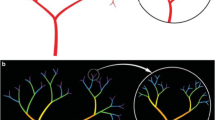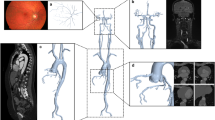Abstract
A mathematical model is derived that describes oxygen concentration in a retinal capillary in terms of the local rate of oxygen utilization and arterial pressure at eye level. The model is applied to describe the loss of vision that occurs upon exposure to acceleration stress.
As applied to animals, the model provides a qualitative explanation for the appearance of experimentally measured acceleration tolerance curves. As applied to man, it offers an excellent correlation of available data. Furthermore, it provides a mechanism for extrapolating experimental results using idealized exposure patterns to the more complex acceleration patterns encountered by pilots in operational situations.
Similar content being viewed by others
References
Anderson, B. andSaltzman, H. A. Retinal oxygen utilization measured by hyperbaric blackout.Archives of Opthalmology, 1964,72, 792–795.
Andina, F. Über “schwarzsehen” als ausdruck von blutdruckschwankungen beim sturzflügen.Schweizerische Medizinische Wochenschrift 1937,18, 753–756.
Bill, A. Ocular circulation. Chap. 6 in Moses, R. A.,Adler's physiology of the eye, 5th ed., St. Louis: C. V. Mosby, 1970.
Burns, J. W. An evaluation of a tilt-back seat as a means of increasing acceleration tolerance. In Preprints of 1973 Annual Scientific Meeting. Aerospace Medical Association, Washington, D. C., 1973.
Duane, T. D. Observations on the fundus oculi during blackout. A.M.A.Archives of Opthalmology 1954,51, 343–355.
Gauer, O. H., andZuidema, G. D. Gravitational stress in aviation medicine. Boston: Little, Brown & Co., 1961.
Green, J. F., andMiller, N. C. A model describing the response of the circulatory system to acceleration stress.Annals of Biomedical Engineering 1973,4, 455–467.
Guyton, A. C. Textbook of medical physiology, 3rd ed. Philadelphia: W. B. Saunders Co., 1966.
Howard, P. Accelerations. In J. A. Gillies (Ed.),A textbook of aviation physiology. New York: Pergamon Press, 1965.
Krogh, A. Number and distribution of capillaries in muscles with calculations of the oxygen pressure head necessary for supplying the tissue.Journal of Physiology (London) 1919,52, 409–415.
Kydd, G. H. Physiologic responses to short durationG z.Aerospace Medicine 1972,43 (9), 1014–1019.
Permutt, S., andRiley, R. L. Hemodynamics of collapsible vessels with tone: the vascular waterfall.Journal of Applied Physiology 1963,18 (2), 924–932.
Rositano, S. A., Mancini, R. E., Krutz, R. W., Jr., andSandler, H. Noninvasive determination of retrograde eye level blood flow as a+G ztolerance indicator. In Preprints of 1973 Annual Scientific Meeting. Aerospace Medical Association, Washington, D. C., 1973.
Stoll, A. M. Human tolerance to positiveG or determined by the physiological end points.Journal of Aviation Medicine 1956,27, 356–367.
Wood, E. H., andLambert, E. H. Some factors which influence the protection afforded by pneumatic anti-g suits.Journal of Aviation Medicine 1952,23, 218–228.
Author information
Authors and Affiliations
Additional information
This work was supported by Air Force Contract No. F44620-72-C-0011.
Rights and permissions
About this article
Cite this article
Miller, N.C., Green, J.F. A model describing acceleration-induced blackout. Ann Biomed Eng 2, 58–68 (1974). https://doi.org/10.1007/BF02368086
Received:
Issue Date:
DOI: https://doi.org/10.1007/BF02368086




